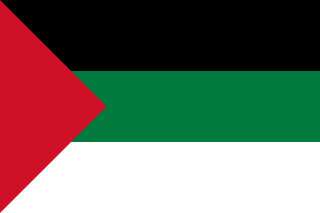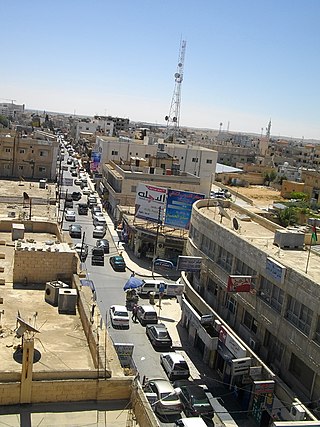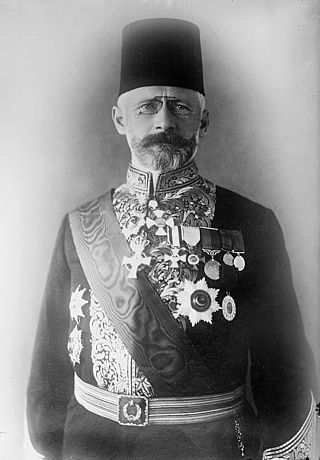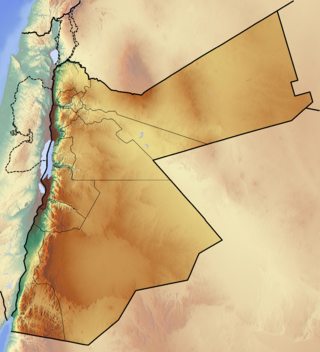
With the exception of a railway system, Jordan has a developed public and private transportation system. There are three international airports in Jordan. The Hedjaz Jordan Railway runs one passenger train a day each way.

The Emirate of Transjordan, officially known as the Amirate of Trans-Jordan, was a British protectorate established on 11 April 1921, which remained as such until achieving formal independence as the Kingdom of Transjordan in 1946.

The Hejaz railway was a narrow-gauge railway that ran from Damascus to Medina, through the Hejaz region of modern-day Saudi Arabia, with a branch line to Haifa on the Mediterranean Sea. The project was ordered by Sultan Abdul Hamid II in March 1900.

The Battle of Megiddo was fought between 19 and 25 September 1918, on the Plain of Sharon, in front of Tulkarm, Tabsor and Arara in the Judean Hills as well as on the Esdralon Plain at Nazareth, Afulah, Beisan, Jenin and Samakh. Its name, which has been described as "perhaps misleading" since very limited fighting took place near Tel Megiddo, was chosen by British commander Edmund Allenby for its biblical and symbolic resonance.

Ma'an is a city in southern Jordan, 218 kilometres (135 mi) southwest of the capital Amman. It serves as the capital of the Ma'an Governorate. Its population was approximately 41,055 in 2015. Civilizations with the name of Ma'an have existed at least since the Nabatean period—the modern city is just northwest of the ancient town. The city is an important transport hub situated on the ancient King's Highway and also on the modern Desert Highway.

The Hashemite Kingdom of Hejaz was a state in the Hejaz region of Western Asia that included the western portion of the Arabian Peninsula that was ruled by the Hashemite dynasty. It was self-proclaimed as a kingdom in June 1916 during the First World War, to be independent from the Ottoman Empire, on the basis of an alliance with the British Empire to drive the Ottoman Army from the Arabian Peninsula during the Arab Revolt.

The Battle of Aqaba was fought for the Red Sea port of Aqaba during the Arab Revolt of World War I. The attacking forces, led by Sherif Nasir and Auda abu Tayi and advised by T. E. Lawrence, were victorious over the Ottoman Empire defenders.

Mafraq is the capital city of Mafraq Governorate in Jordan, located 80 km to the north of the national capital, Amman. It is located at a crossroads, with a road north going to Syria and another road to the east going to Iraq. It had 56,340 inhabitants in 2004.

The Jezreel Valley railway, or the Valley Train was a railroad that existed in Ottoman and British Palestine, reconstituted as a modern railway in Israel in the 21st century. It runs from the Mediterranean coast inland along the length of the Jezreel Valley. The historical line was a segment of the longer Haifa–Dera'a Line, which was itself a branch of the larger Hejaz railway.

General Establishment of Syrian Railways is the national railway operator for the state of Syria, subordinate to the Ministry of Transportation. It was established in 1956 and was headquartered in Aleppo. Syria's rail infrastructure has been severely compromised as a result of the ongoing conflict in the country.
Jordan has a total of 507 km of narrow gauge railways as of 2008.

Hejaz railway station is a former main railway station in central Damascus, Syria, close to the Marjeh Square. It was built as part of the Hejaz railway project.

The Aqaba Railway Corporation (ARC) was a railway company operating in southern Jordan. The railway was formed in 1979 to transport phosphate to the port in Aqaba. It used the tracks of the Hejaz Railway partly. It was closed in 2018
The Damascus–Amman train or Damascus–Amman railway is an international train service operating on the former Hedjaz Railway from Damascus, Syria to Amman, Jordan. It is currently the only passenger train operating in Jordan. The train operates on narrow gauge tracks of 1,050 mm.
This is a timeline of major events in the history of the modern state of Jordan.
The Third Transjordan attack by Chaytor's Force, part of the British Empire's Egyptian Expeditionary Force (EEF), took place between 21 and 25 September 1918, against the Ottoman Empire's Fourth Army and other Yildirim Army Group units. These operations took place during the Battle of Nablus, part of the Battle of Megiddo which began on 19 September in the final months of the Sinai and Palestine campaign of World War I. Fought on the right flank and subsidiary to the Battle of Nablus, the Third Transjordan attack began northwards, with the assault on Kh Fasail. The following day a section of Chaytor's Force, attacked and captured the Ottoman Empire's 53rd Division on the main eastwards line of retreat out of the Judean Hills across the Jordan River. Retreating columns of the Yildirim Army Group were attacked during the battle for the Jisr ed Damieh bridge, and several fords to the south were also captured, closing this line of retreat. Leaving detachments to hold the captured bridge and fords, Chaytor's Force began their eastwards advance by attacking and capturing the Fourth Army garrison at Shunet Nimrin on their way to capture Es Salt for a third time. With the Fourth Army's VIII Corps in retreat, Chaytor's Force continued their advance to attack and capture Amman on 25 September during the Second Battle of Amman. Several days later, to the south of Amman, the Fourth Army's II Corps which had garrisoned the southern Hejaz Railway, surrendered to Chaytor's Force at Ziza, effectively ending military operations in the area.

Heinrich August Meissner was a German engineer who was largely responsible for the railway network in the Ottoman Empire, and later helped manage the network in Turkey. He attained the high-ranking honorary title of pasha in the empire.

Mudawwara is the most southerly settlement in Jordan. It is administratively part of the Ma'an Governorate. The village had a population of 691 in the 2015 census.

The Occupation of Ma'an was the post-World War I occupation of the Sanjak of Ma'an, which straddled the regions of Syria and Arabia, by members of the Hashemite family, who came to power in various regions of the Near East and Arabia; they were King Hussein in the Kingdom of Hejaz, Emir Faisal representing the Arab government in Damascus and Abdullah, who was to become Emir of Transjordan. The region includes the governorates of Ma'an and Aqaba, today in Jordan, as well as the area which was to become a large part of the Israeli Southern District, including the city of Eilat.

The Jordan–Saudi Arabia border is 731 km (454 mi) in length and runs from the Gulf of Aqaba in the south-west to the tripoint with Iraq in the north-east.















